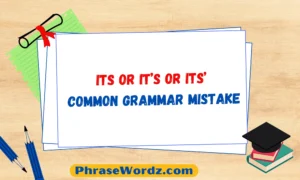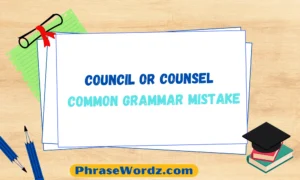When it comes to “I,” “me,” and “my,” even native English speakers often struggle with when to use each correctly. These three pronouns may seem simple, but confusing them can result in awkward or incorrect sentences.
Understanding the difference between I, me, and my can eliminate common grammar mistakes. Use I as a subject, me as an object, and my to show possession. For example: “I went, she called me, and that’s my book.”
Understanding their proper usage is essential to mastering English grammar, and this article will break down their distinctions with examples and in-depth explanations.
“I” – The Subject Pronoun
“I” is used when the speaker is the subject of the sentence, meaning the person doing the action. When you use “I,” you are referring to yourself as the one who performs or initiates the action.
Examples:
- I went to the store.
- I am reading a new book.
- I love to travel with my friends.
In these sentences, “I” is the subject doing the action: going to the store, reading, and loving to travel. If you’re the one acting, you should use “I.”
Scenario Example 1: Writing a Formal Email
Email Example:
Subject: Proposal for Upcoming Event
Hi Mia,
I wanted to reach out and discuss our plans for the upcoming charity event. I have a few ideas that I believe could make a significant impact. Could we schedule a meeting next week to go over the details?
I look forward to hearing your thoughts!
Best,
Hannah
“Me” – The Object Pronoun
“Me” is used when you are the object of the action or when something is happening to you. It is often used after prepositions like “to,” “for,” or “with.”
Examples:
- The teacher called me after class.
- They invited me to the party.
- Could you help me with this project?
In these sentences, “me” is the recipient of the action: being called, invited, and helped. Whenever you’re receiving the action in a sentence, “me” is the correct choice.
Scenario Example 2: Casual Conversation via Text
Text Example:
Hey Mia,
Sarah just called me about the weekend trip. She wanted to know if we could adjust our schedule slightly. I told her that was fine with me. What do you think?
Let me know,
Hannah
“My” – The Possessive Pronoun
“My” is used to show possession or ownership. If something belongs to you, you’ll use “my” to clarify that you are the owner of that object, feeling, or situation.
Examples:
- That’s my car parked outside.
- My friends are coming over later.
- I can’t find my keys.
In these sentences, “my” is used to show possession of the car, friends, and keys. If you own or are associated with something, “my” is the correct choice.
Scenario Example 3: Writing a Personal Update
Email Example:
Subject: Update on My New Job
Hi Mia,
Just wanted to give you an update on how things are going with my new job. My team has been incredibly supportive, and my boss is approachable. It’s a big change from my last position, but I think I am settling in well.
Would love to catch up soon and hear about everything going on with you!
Take care,
Hannah
Common Mistakes
1. Using “I” Instead of “Me”
It’s common for people to mistakenly use “I” when “me” should be used, particularly in compound subjects or objects. For example:
- Incorrect: Sarah and I went to the party. (This is correct.)
- Incorrect: They invited Sarah and I to the party. (This is incorrect; it should be “me.”)
When deciding between “I” and “me,” try removing the other person from the sentence to see which sounds right. For instance:
- Without Sarah: They invited I to the party. (Incorrect)
- Without Sarah: They invited me to the party. (Correct)
2. Using “Me” Instead of “I”
On the flip side, people sometimes use “me” in place of “I” when speaking about themselves and others in the subject position.
- Incorrect: Me and Mia are going shopping. (It should be “Mia and I.”)
- Incorrect: Me and my friend want to travel. (It should be “My friend and I.”)
3. Confusing “My” with “Me” or “I”
Occasionally, people mix up “my” with “me” or “I” when showing possession. For example:
- Incorrect: Me car is outside. (It should be “My car is outside.”)
- Incorrect: That’s I car. (It should be “That’s my car.”)
How to Remember the Difference
- “I” = The doer of the action. If you’re acting, use “I.”
- Think: “I am doing something.”
- “Me” = The receiver of the action. If something is happening to you, use “me.”
- Think: “Someone is helping me.”
- “My” = Shows ownership. If something belongs to you, use “my.”
- Think: “That is my object.”
Quick Tips
- I is always the subject of a sentence: “Mia and I went to the meeting.”
- Me is the object of a sentence: “He gave the documents to Mia and me.”
- My is used to show possession: “That is my report.”
Why Is This a Common Mistake?
- Overcorrection: Many people have been corrected for using “me” improperly, leading them to overuse “I” in places where “me” is correct. For example, “They gave it to Sarah and I” sounds formal but is incorrect.
- Complex Sentences: When sentences get more complex, it’s easy to lose track of who is the subject and who is the object. This is especially true when there’s more than one person involved in the sentence.
- Speaking vs. Writing: In spoken English, people often don’t notice these mistakes because we tend to be more relaxed in casual conversation. However, in writing, the errors stand out more clearly.
Final Thoughts
Mastering the difference between “I,” “me,” and “my” can greatly improve your clarity and professionalism in both writing and speaking. By understanding the roles each pronoun plays in a sentence, you can avoid these common grammar mistakes and communicate more effectively.
Now that you know the difference, practice is key! Whether you’re writing emails, chatting with friends, or giving formal presentations, keep these distinctions in mind, and you’ll become more confident with your pronoun usage.











